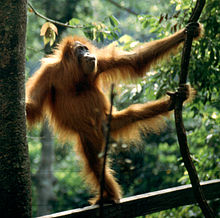At 1,919,440 square kilometers (741,050 sq mi), Indonesia is the world's 16th-largest country in terms of land area.[88] Its average population density is 134 people per square kilometer (347 per sq mi), 79th in the world,[89] although Java, the world's most populous island,[90] has a population density of 940 people per square kilometer (2,435 per sq mi). At 4,884 metres (16,024 ft), Puncak Jaya in Papua is Indonesia's highest peak, and Lake Toba in Sumatra its largest lake, with an area of 1,145 square kilometers (442 sq mi). The country's largest rivers are in Kalimantan, and include the Mahakam and Barito; such rivers are communication and transport links between the island's river settlements.[91]

Mount Semeru and Mount Bromo in East Java. Indonesia's seismic and volcanic activity is among the world's highest.
Lying along the equator, Indonesia has a tropical climate, with two distinct monsoonal wet and dry seasons. Average annual rainfall in the lowlands varies from 1,780–3,175 millimeters (70–125 in), and up to 6,100 millimeters (240 in) in mountainous regions. Mountainous areas—particularly in the west coast of Sumatra, West Java, Kalimantan, Sulawesi, and Papua—receive the highest rainfall. Humidity is generally high, averaging about 80%. Temperatures vary little throughout the year; the average daily temperature range of Jakarta is 26–30 °C (79–86 °F).[95]
Biota and environment
Indonesia is second only to Australia in terms of total endemic species, with 36% of its 1,531 species of bird and 39% of its 515 species of mammal being endemic.[101] Indonesia's 80,000 kilometers (50,000 mi) of coastline are surrounded by tropical seas that contribute to the country's high level of biodiversity. Indonesia has a range of sea and coastal ecosystems, including beaches, sand dunes, estuaries, mangroves, coral reefs, sea grass beds, coastal mudflats, tidal flats, algal beds, and small island ecosystems.[8] Indonesia is one of Coral Triangle countries with the world's greatest diversity of coral reef fish with more than 1,650 species in eastern Indonesia only.[102] The British naturalist, Alfred Wallace, described a dividing line between the distribution and peace of Indonesia's Asian and Australasian species.[103] Known as the Wallace Line, it runs roughly north-south along the edge of the Sunda Shelf, between Kalimantan and Sulawesi, and along the deep Lombok Strait, between Lombok and Bali. West of the line the flora and fauna are more Asian; moving east from Lombok, they are increasingly Australian. In his 1869 book, The Malay Archipelago, Wallace described numerous species unique to the area.[104] The region of islands between his line and New Guinea is now termed Wallacea.[103]
Indonesia's high population and rapid industrialization present serious environmental issues, which are often given a lower priority due to high poverty levels and weak, under-resourced governance.[105] Issues include large-scale deforestation (much of it illegal) and related wildfires causing heavy smog over parts of western Indonesia, Malaysia and Singapore; over-exploitation of marine resources; and environmental problems associated with rapid urbanization and economic development, including air pollution, traffic congestion, garbage management, and reliable water and waste water services.[105] Deforestation and the destruction of peatlands make Indonesia the world's third largest emitter of greenhouse gases.[106] Habitat destruction threatens the survival of indigenous and endemic species, including 140 species of mammals identified by the World Conservation Union (IUCN) as threatened, and 15 identified as critically endangered, including Bali Starling,[107] Sumatran Orangutan,[108] and Javan Rhinoceros.[107] Much of Indonesia's deforestation is caused by forest clearing for the palm oil Industry, which has cleared 18 million hectares of forest for palm oil expansion. Palm oil expansion requires land reallocation as well as changes to the local and natural ecosystems. Palm oil expansion can generate wealth for local communities if done right. If down wrong it can degrade ecosystems and cause social conflicts.[109]

Tidak ada komentar:
Posting Komentar